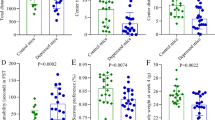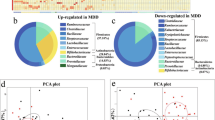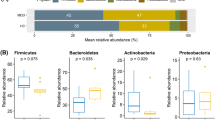Abstract
Gut microbiota homeostasis in the organism and insomnia have been reported to influence each other. In the study, a method of 16S rRNA gene sequencing combined with ultra-high performance liquid chromatography-mass/mass spectrometry was adopted to evaluate the effects of Lilium brownie (LB) on intestinal flora and metabolic profiles of serum, hypothalamus and hippocampus in insomnia rat induced by p‑chlorophenylalanine (PCPA). It was observed that the imbalance in the diversity and abundance of gut microbiota induced by PCPA was restored after LB intervention. Among these, the Porphyromonadaceae, Lactobacillus and Escherichia were significantly adjusted at the genus level by PCPA and LB, respectively. It was also found that the most of metabolic phenotypes in serum, hypothalamus and hippocampus perturbed by PCPA were regulated towards normal after LB intervention, especially 5-hydroxy-l-tryptophan of the hypothalamus involving in 5-HT metabolism. Moreover, the arachidonic acid metabolism in serum, hypothalamus and hippocampus, and the serotonergic synapse in hypothalamus and hippocampus were the most fundamentally and significantly affected pathways after LB intervention. The results of correlation analysis showed that several floras including Pseudoruegeria have an outstanding contribution to the change of differential metabolites. In brief, the results confirm that gut microbiota is significantly returned to normal and may interact with the corresponding metabolites to relieve insomnia under LB intervention.






Similar content being viewed by others
References
Shi R, Han Y, Yan Y, Qiao HY, He J, Lian WW, Xia CY, Li TL, Zhang WK, Xu JK (2019) Loganin exerts sedative and hypnotic effects via modulation of the serotonergic system and GABAergic neurons. Front Pharmacol 10:409
Krystal AD, Benca RM, Kilduff TS (2013) Understanding the sleep-wake cycle: sleep, insomnia, and the orexin system. J Clin Psychiatry 74:3–20
Stewart R, Besset A, Bebbington P, Brugha T, Lindesay J, Jenkins R, Singleton N, Meltzer H (2006) Insomnia comorbidity and impact and hypnotic use by age group in a national survey population aged 16 to 74 years. Sleep 29:1391–1397
Nishichi R, Nufuji Y, Washio M, Kumagai S (2013) Serum brain-derived neurotrophic factor levels are associated with dyssomnia in females, but not males, among Japanese workers. J Clin Sleep Med 9:649–654
Knutson KL, Spiegel K, Penev P, Van Cauter E (2007) The metabolic consequences of sleep deprivation. Sleep Med Rev 11:163–178
Portaluppi F, Cortelli P, Avoni P, Vergnani L, Contin M, Maltoni P, Pavani A, Sforza E, degli Uberti EC, Gambetti P (1994) Diurnal blood pressure variation and hormonal correlates in fatal familial insomnia. Hypertension 23:569–576
Wallander M, Johansson S, RuigómezGarc´ıa Rodr´ıguez L A, Jones R, A (2007) Morbidity associated with sleep disorders in primary care: a longitudinal cohort study. Prim Care Companion J Clin Psychiatry 9:338–345
Resnick HE, Redline S, Shahar E, Gilpin A, Newman A, Walter R, Ewy GA, Howard BV, Punjabi NM (2003) Diabetes and sleep disturbances: findings from the Sleep Heart Health Study. Diabetes Care 26:702–709
Neubauer DN, Pandi-Perumal SR, Spence DW, Buttoo K, Monti JM (2018) Pharmacotherapy of insomnia. J Cent Nerv Syst Dis 10:1–7
Si Y, Wang L, Lan J, Li H, Guo T, Chen X, Dong C, Ouyang Z, Chen SQ (2020) Lilium davidii extract alleviates p-chlorophenylalanine-induced insomnia in rats through modification of the hypothalamic-related neurotransmitters, melatonin and homeostasis of the hypothalamic-pituitary-adrenal axis. Pharm Biol 58:915–924
Teichman EM, O’Riordan KJ, Gahan CGM, Dinan TG, Cryan JF (2020) When rhythms meet the blues: circadian interactions with the microbiota-gut-brain axis. Cell Metab 31:448–471
Clarke G, Sandhu KV, Griffin BT, Dinan TG, Cryan JF, Hyland NP (2019) Gut reactions: breaking down xenobiotic-microbiome interactions. Pharmacol Rev 71:198–224
Szentirmai E, Millican NS, Massie AR, Kapás L (2019) Butyrate, a metabolite of intestinal bacteria, enhances sleep. Sci Rep 9:7035
Collins SM, Surette M, Bercik P (2012) The interplay between the intestinal microbiota and the brain. Nat Rev Microbiol 10:735–742
Lin A, Shih CT, Huang CL, Wu CC, Lin CT, Tsai YC (2019) Hypnotic effects of Lactobacillus fermentum PS150TM on pentobarbital-induced sleep in mice. Nutrients 11:2409
Hsiao EY, McBride SW, Hsien S, Sharon G, Hyde ER, McCue T, Codelli JA, Chow J, Reisman SE, Petrosino JF, Patterson PH, Mazmanian SK (2013) Microbiota modulate behavioral and physiological abnormalities associated with neurodevelopmental disorders. Cell 155:1451–1463
Medina-Rodriguez EM, Madorma D, O’Connor G, Mason BL, Han D, Deo SK, Oppenheimer M, Nemeroff CB, Trivedi MH, Daunert S, Beurel E (2020) Identification of a signaling mechanism by which the microbiome regulates Th17 cell-mediated depressive-like behaviors in mice. Am J Psychiatry 177:974–990
Wagner-Skacel J, Dalkner N, Moerkl S, Kreuzer K, Farzi A, Lackner S, Painold A, Reininghaus EZ, Butler MI, Bengesser S (2020) Sleep and microbiome in psychiatric diseases. Nutrients 12:2198
Parkar SG, Kalsbeek A, Cheeseman JF (2019) Potential role for the gut microbiota in modulating host circadian rhythms and metabolic health. Microorganisms 7:41
Ling L, Jiao Z, Ma W, Zhao J, Feng J, Zhang X, Li Z, Zhang J, Lu L (2018) Preliminary report on the study of postharvest fruit rot bacteria and yeasts in Lanzhou lily (Lilium davidii var. unicolor) in China. J Phytopathol 167:135–145
Munafo JP, Gianfagna TJ (2015) Chemistry and biological activity of steroidal glycosides from the Lilium genus. Nat Prod Rep 32:454–477
Quan SJ, Lin XE, Liu N (2006) Study on syndrome attribute of PCPA rat insomnia model. Chin Arch Tradit Chin Med 24:450–451
Touret M, Sarda N, Gharib A, Geffardet M, Jouvet M (1991) The role of 5-hydroxytryptophan (5-HTP) in the regulation of the sleep/wake cycle in parachlorophenylalanine (p-CPA) pretreated rat: a multiple approach study. Exp Brain Res 86:117–124
Sallanon M, Buda C, Janin M, Jouvet M (1982) 5-HT antagonists suppress sleep and delay its restoration after 5-HTP in p-chlorophenylalanine-pretreated cats. Eur J Pharmacol 82:29–35
Yan Y, Li Q, Du HZ, Shen CX, Li AP, Pei XP, Du CH, Qin XM (2019) Determination of five neurotransmitters in the rat brain for the study of the hypnotic effects of Ziziphi spinosae semen aqueous extract on insomnia rat model by UPLC-MS/MS. Chin J Nat Med 17:551–560
Prather AA, Janicki-Deverts D, Adler NE, Hall M, Cohen S (2017) Sleep habits and susceptibility to upper respiratory illness: the moderating role of subjective socioeconomic status. Ann Behav Med 51:137–146
Li Y, Hao Y, Fan F, Zhang B (2018) The role of microbiome in insomnia, circadian disturbance and depression. Front Psychiatry 9:669
Davies SK, Ang JE, Revell VL, Holmes B, Mann A, Robertson FP, Cui N, Middleton B, Ackermann K, Kayser M, Thumser AE (2014) Raynaud FI. Skene DJ. Effect of sleep deprivation on the human metabolome. Proc Natl Acad Sci USA 111:10761–10766
Johnston JD, Ordovás JM, Scheer FA, Turek FW (2016) Circadian rhythms, metabolism, and chrononutrition in rodents and humans. Adv Nutr 7:399–406
Wu T, Yang L, Jiang J, Ni Y, Zhu J, Zheng X, Wang Q, Lu X, Fu Z (2018) Chronic glucocorticoid treatment induced circadian clock disorder leads to lipid metabolism and gut microbiota alterations in rats. Life Sci 192:173–182
Ackerman HD, Gerhard GS (2016) Bile acids in neurodegenerative disorders. Front Aging Neurosci 8:263
Kiriyama Y, Nochi H (2019) The biosynthesis, signaling, and neurological functions of bile acids. Biomolecules 9:232
Chokroverty S (2017) Sleep disorders medicine: basic science, technical considerations and clinical aspects: Fourth edition. In: Hirshkowitz M, Bhandari H (eds) Neurotransmitters, neurochemistry, and the clinical pharmacology of sleep. Springer, New York, pp 103–118
de-Miguel FF, Trueta C (2005) Synaptic and extrasynaptic secretion of serotonin. Cell Mol Neurobiol 25:297–312
Lepetit P, Touret M, Grange E, Gay N, Bobillier P (1991) Inhibition of methionine incorporation into brain proteins after the systemic administration of p-chlorophenylalanine and L-5-hydroxytryptophan. Eur J Pharmacol 209:207–212
Shi HY, Lu Y, Li YX, Tian FZ (2018) Research progress of treatment with Chinese medicine for insomnia rats induced by PCPA. China Med Her 15:33–36
Maffei ME (2020) 5-Hydroxytryptophan (5-HTP): natural occurrence, analysis, biosynthesis, biotechnology, physiology and toxicology. Int J Mol Sci. https://doi.org/10.3390/ijms22010181
Turner EH, Loftis JM, Blackwell AD (2006) Serotonin a la carte: supplementation with the serotonin precursor 5-hydroxytryptophan. Pharmacol Ther 109:325–338
Funding
This research was funded by financial support from the Chinese Postdoctoral Science Foundation (2017M623342).
Author information
Authors and Affiliations
Corresponding authors
Ethics declarations
Conflict of interest
The authors declare no conflict of interest.
Additional information
Publisher's Note
Springer Nature remains neutral with regard to jurisdictional claims in published maps and institutional affiliations.
Rights and permissions
About this article
Cite this article
Si, Y., Chen, X., Guo, T. et al. Comprehensive 16S rDNA Sequencing and LC–MS/MS-Based Metabolomics to Investigate Intestinal Flora and Metabolic Profiles of the Serum, Hypothalamus and Hippocampus in p‑Chlorophenylalanine-Induced Insomnia Rats Treated with Lilium brownie. Neurochem Res 47, 574–589 (2022). https://doi.org/10.1007/s11064-021-03466-z
Received:
Revised:
Accepted:
Published:
Issue Date:
DOI: https://doi.org/10.1007/s11064-021-03466-z




